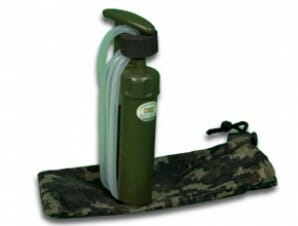Emergencies require fortitude, prior planning, knowledge, and tools to get through, but the most important focus should be on the essential life components: food, water, and shelter.
 Life requires water, and that is the focus of this article. How does one produce, store, and maintain enough of a supply to stay alive and even thrive in the midst and the aftermath of an emergency?
Life requires water, and that is the focus of this article. How does one produce, store, and maintain enough of a supply to stay alive and even thrive in the midst and the aftermath of an emergency?
An emergency doesn’t have to be a life-changing, death-causing terrorist event or natural disaster, though it can include them; an emergency is simply a scenario which is unexpected and threatens to disrupt the quality of life or upset the normalcy of a situation to the point where it could become dangerous. Your biggest concern in such a situation is always to ensure that everyone is healthy and out of the reach of life-threatening illness and injury, but secondly, and probably more common a concern in normal situations, is to ensure fresh, clean water is available to keep life sustained.
Water is a commodity, as plentiful as it seems, and tends to be taken for granted until emergency situations arrive. The truth, however, is that fresh water is not as plentiful as it may seem. It requires a bit of knowledge and some tools to get it to the point where it can be used safely.
Three basic concepts with drinking and cooking water that should be paid attention to are:
- Killing bacteria and viruses
- Making sure taste is absent as much as possible
- Being smart with your consumption and ensuring people stay hydrated
Failure to utilize any of these guidelines can have a profound effect on your situation.
Killing bacteria and viruses is the most important part to the equation, as failure to do so will result in dehydration (through loss of bodily fluids as a result of diarrhea and vomiting), infection, or extreme discomfort.
*Important note: If there is a chemical in contact with a water source, it’s impossible to treat the water enough to make it safe for consumption. If there is an odor, color, or taste to water that concerns you, look for other sources. If it is widely known that a water source has been in contact with any industrial, commercial, or naturally occurring organic chemical, look for other sources. Even trace amounts of chemicals can cause sickness or death. No amount of treatment will take the danger out of the water supply in such a case. DO NOT CONSUME!
Water purification techniques are many and varied, and your usage of them should be as well; each of these techniques has its place in your system, and each can provide usefulness where the others cannot.
Boiling water is the original and perhaps the most foolproof method when simply treating for bacteria and viruses. Few life forms can survive temperatures in excess of those produced by boiling for a few minutes. However, it is a method that requires a fuel or heat source, time, and smart handling. If you have sustainable solar energy (or another form), you can conceivably use boiling as your primary water treatment method
Mechanical Filtration
An economical and long-lasting solution with the proper tools, mechanical filtration can treat for taste and non-chemical organic contamination, as well as for bacteria and viruses. There are hundreds of manufacturers and types of mechanical filters, but all will render water safe to drink as long as nuclear or chemical degradation has not occurred. Below is a list of types of filters and their unique properties.
Gravity filters: An excellent choice when large parties are involved or the need for economy or ease of cleaning exists. Take a look at Platypus Gravity Works Water filter for an example: it’s incredibly easy to use, comprehensive, and inexpensive. It can treat thousands of gallons of water over its useful life. Katydyn, Pur, and others make excellent quality filters as well, and each can provide a no-work production of a gallon of water in no time.
Hand filters: They are brutally efficient and relatively cheap. Physical hand filters will provide tangibility to your efforts to obtain water and will result in a useable, safe-to-drink quantity in proportion to your physical work for it. Many brands and models exist, and one does not necessarily work more efficiently than another. Make sure to grab a couple quality filters, some spare parts and replacement elements, and don’t forget to stash them in places where you have access to in emergency situations like the car trunk, the closet, and even the office if you are planning ahead.
*Important note: Prefilters can work wonders for keeping your element from clogging too fast, filtering out sediment and rocks, and most importantly, taking out odors and tastes present in stagnant or naturally occurring water. Charcoal pre-filters can effectively remove tastes and smells in your drinking water, but they can only go so far. Be prepared to treat for these concerns in other ways or just deal with them.
Chemical Treatments
These are the only chemicals you want to come in contact with your drinking water in any situation. These chemicals are made specifically to kill the bacteria and viruses potentially inside your water and can render safe water out of many different typically unsafe water sources. These chemicals can vary but generally are made from chlorine dioxide and come in brand names including Aqua, AquaMira, and MicroPur. They are incredibly cheap, and although they can go bad eventually, they have an excellent shelf life. Remember though, when in doubt, filter or boil to treat water.
Other Treatment Types
Straw filters are mostly gimmicky, though some decent quality models are in production now. Be careful when you fill the container and when you wash it or you risk contamination of the straw. This also goes for contact via your mouth with illness-causing bacteria or viruses.
Steripen is a UV light powered by batteries that can purify small quantities of water quickly without manual labor and has an excellent effective rate of purification. As the technology improves, larger quantities will be able to be treated and with faster results. It’s relatively inexpensive, good to have around in multiple places, and it is essentially foolproof
Taste and smell in water can come from a variety of sources: it’s key to determine the cause, and ensure there are no health risks associated with it. It may just be that the water has been stagnant for a long time, and needs to be filtered properly to remove dangerous bacteria and viruses, in which case a charcoal filter will go a long way in removing the taste and smell.
Rationing may not be the best word for a situation where water is a priceless item, but rationing is exactly what it is. FEMA says no to rationing—if rationing means not drinking water so that you can stay dehydrated while you don’t do anything to increase your water supply (which is their definition of water rationing). FEMA would probably say YES to water rationing if the world realized it’s more about prudent water consumption and everyone stays hydrated.
Your goal is to produce enough fresh water to keep from having to ration, regardless of your specific definition of the word. Produce a stockpile early on, add that to the storage you already have, and be prudent with your usage so it’s not wasted. It’s relatively simple with the right mindset, tools, and work.
©2011 Off the Grid News
—————————————————————–
